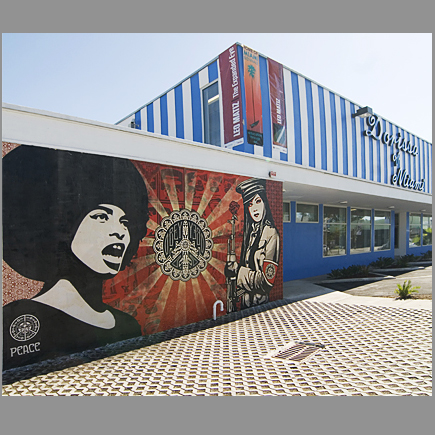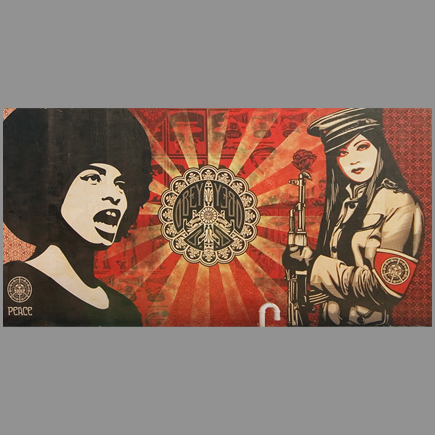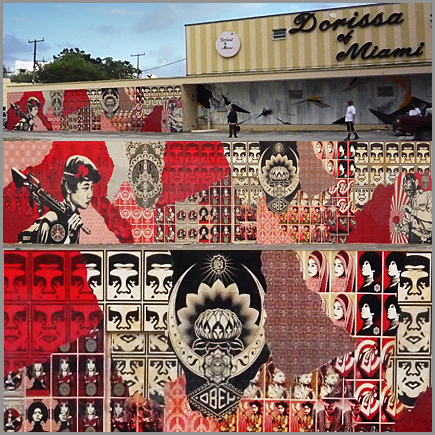Art Works |
Video |
||
 Shepard Fairey, Miami, 2010
Shepard Fairey, Miami, 2010
Exterior mural; 12 x 30 feet Dorissa Mural 2010: Shepard Fairey Mural 2010  Shepard Fairey, Miami, 2010
Shepard Fairey, Miami, 2010
Exterior mural; 12 x 30 feet Dorissa Mural 2010: Shepard Fairey Mural 2010  Shepard Fairey, Miami, 2008
Shepard Fairey, Miami, 2008
Exterior mural; 12 x 100 feet Dorissa Mural 2008: Art Basel Mural Fest 2008 |
Return to: Artist Biographies
|
||
| After graduation, he founded a small printing business in Providence, Rhode Island, called Alternate Graphics, specializing in t-shirt and sticker silkscreens, which afforded Fairey the ability to continue pursuing his own artwork. While residing in Providence in 1994, Fairey met American filmmaker Helen Stickler, who had also attended RISD and graduated with a film degree. The following spring, Stickler completed a short documentary film about Shepard and his work, titled "Andre the Giant has a Posse". The film premiered in the 1995 New York Underground Film Festival, and went on to play at the 1997 Sundance Film Festival. It has been seen in more than 70 festivals and museums internationally.
Fairey was a founding partner, along with Dave Kinsey and Phillip DeWolff, of the design studio BLK/MRKT Inc. from 1997–2003, which specialised in guerilla marketing, and "the development of high-impact marketing campaigns".Clients included Pepsi, Hasbro and Netscape (for whom Fairey designed the red dinosaur version of mozilla.org's logo and mascot). OBEY Giant clothing sold at a Nordstrom department storeIn 2003 he founded the Studio Number One design agency with his wife Amanda Fairey. The agency produced the cover work for the Black Eyed Peas' album Monkey Business and the poster for the film Walk the Line. Fairey has also designed the covers for The Smashing Pumpkins' album Zeitgeist, Flogging Molly's CD/DVD Whiskey on a Sunday, the Led Zeppelin compilation Mothership and Anthrax's The Greater Of Two Evils. In 2004, Fairey joined artists Robbie Conal and Mear One to create a series of "anti-war, anti-Bush" posters for a street art campaign called "Be the Revolution" for the art collective "Post Gen". "Be the Revolution" kicked off with a night of performances featuring Z-Trip, Ozomatli and David J at the Avalon in Hollywood. Fairey also co-founded Swindle Magazine along with Roger Gastman. In 2005 he collaborated for a second time with Z-Trip on a limited edition 12-inch featuring Chuck D entitled "Shock and Awe." In 2005 Fairey also collaborated with DJ Shadow on a box set, with t-shirts, stickers, prints, and a mix CD by Shadow. In 2005 also, he was a resident artist at the Contemporary Museum, Honolulu. Also in 2005 Fairey contributed the artwork for the posters, cover art, and graphics for the biopic of Johnny Cash, Walk The Line. In 2006, Fairey contributed eight vinyl etchings to a limited-edition series of 12" singles by post-punk band Mission of Burma, and has also done work for the musical group Interpol. The book Supply and Demand: The Art of Shepard Fairey was released in 2006. In 2008, Philosophy of Obey (Obey Giant): The Formative Years (1989–2008), edited by Sarah Jaye Williams, was published by Nerve Books UK, and praised by Fairey. Fairey working with Hawaii-themed art at an official installation at the Makiki Skate ParkIn June 2007, Fairey opened his one man show entitled "E Pluribus Venom", at the Jonathan LeVine Gallery. The show made the arts section front page in The New York Times. Fairey donated original cover art to the 2008 album Body of War: Songs That Inspired an Iraq War Veteran, produced for Iraq War documentary Body of War. Proceeds from the album benefit non-profit organization Iraq Veterans Against the War. In 2008 Fairey teamed up again with Z-Trip to do a series of shows in support of then presidential candidate Barack Obama entitled Party For Change. Fairey also designed posters for the British goth band Bauhaus. In September 2008, Shepard opened his solo show titled "Duality of Humanity" at The Shooting Gallery in San Francisco. His third solo show with the gallery featured one hundred and fifty works, including the largest collection of canvases pieces in one show that he's done. Fairey was arrested on February 7, 2009, on his way to the premiere of his show at the Institute of Contemporary Art in Boston, Massachusetts, on two outstanding warrants related to graffiti. He was charged with damage to property for having postered two Boston area locations with graffiti, a Boston Police Department spokesman said. His arrest was announced to party goers by longtime friend Z-Trip who had been performing at the ICA premiere at Shepard Fairey's request. On April 27, 2009, Fairey put three signed copies of his Obama inauguration posters up on eBay, with the proceeds of the auction going to the One Love For Chi foundation, founded by the family of Deftones bassist Chi Cheng following a car accident in November 2008 that nearly claimed Cheng's life. Lance Armstrong will ride a Trek Madone styled by Fairey in the Giro d'Italia in Venice, Italy. Barack Obama "Hope" poster Fairey distributed 300,000 stickers and 500,000 posters during the campaign, funding his grassroots electioneering through poster and fine art sales. "I just put all that money back into making more stuff, so I didn't keep any of the Obama money," said Fairey in December 2008. In February 2008, Fairey received a letter of thanks from Obama for his contribution to the campaign. The letter stated: “ I would like to thank you for using your talent in support of my campaign. The political messages involved in your work have encouraged Americans to believe they can change the status-quo. Your images have a profound effect on people, whether seen in a gallery or on a stop sign. I am privileged to be a part of your artwork and proud to have your support. – Barack Obama, February 22, 2008 ” Fairey created a similar but new image of Barack Obama for Time Magazine, which was used as the cover art for the 2008 Person of the Year issue. The original iconic "HOPE" portrait was featured on the cover of Esquire Magazine's February 2009 issue, this time with a caption reading, "WHAT NOW?" Shepard Fairey's influence throughout the presidential election was a factor in the artist himself having been named a Person of the Year for 2008 by GQ. In January 2009, the "HOPE" portrait was acquired by the US National Portrait Gallery and made part of its permanent collection. It was unveiled and put on display on January 17, 2009. Legal issues with appropriation and fair use In 2009, it was revealed that the HOPE poster was based on a copyrighted photograph taken in April 2006 by Mannie Garcia while on assignment for the Associated Press (AP), which wants credit and compensation for the work. However, Garcia believes that he personally owns the copyright for the photo, and has said, "If you put all the legal stuff away, I’m so proud of the photograph and that Fairey did what he did artistically with it, and the effect it's had." Fairey has said that his use of it falls within the legal definition of fair use. Lawyers for both sides were discussing an amicable agreement. In February 2009, Fairey filed a federal lawsuit against the Associated Press, seeking a declaratory judgment that his use of the AP photograph was protected by the fair use doctrine and so did not infringe their copyright. In October 2009 Shepard Fairey admitted to trying to deceive the Court by destroying evidence that he had used the photograph alleged by the AP. His lawyers announced they were no longer representing him, and Laurence Pulgram, an intellectual property lawyer stated that the revelation definitely put Mr. Fairey's case "in trouble". In May 2010, a judge urged Fairey to settle. Critical response Erick Lyle has accused Fairey of cynically turning graffiti culture into a self-promoting ad campaign.[51] On the other hand, San Diego Union-Tribune art critic Robert L. Pincus says Fairey's work "is political art with a strong sense of visual style and emotional authenticity. Even in times when political art has ebbed, Fairey's has just the right balance of seriousness, irony and wit to fit the mood of the moment." The Walrus contributor Nick Mount wrote "Following the example set by gallery art, some street art is more about the concept than the art. 'Fuck Bush' isn’t an aesthetic; it’s an ethic. Shepard Fairey’s Obey Giant stickers and Akay’s Akayism posters are clever children of Duchamp, ironic conceptual art." However, Stephen Heller of The New York Times suggested that Fairey’s political art is not any more unique than political art from the past, yet compares, in fact and in equal terms, to political art created by Andy Warhol. In a review of "E Pluribus Venom" at Jonathan LeVine Gallery for The New York Times art critic Benjamin Genocchio stated that Fairey’s art comes off as “generic” despite the range of mediums and styles used by the artist. Genocchio went on to say that it was tempting to see Fairey’s art as just another luxury commodity. The director of Ad Hoc Art, Andrew Michael Ford, has stated for the New York Times that Fairey‘s practice does not “match up“ in the minds of people who view his work. Ford suggests that some people will view Fairey’s work as “very commercial”. In his criticism of Fairey’s art he went on to suggest that Fairey is “ripe” for criticism because he profits off of politically and socially charged works. Ford stated that despite his criticism he is a fan of Fairey work. Mark Vallen, Lincoln Cushing, Josh MacPhee, and Favianna Rodriguez have documented how Fairey has appropriated work by Koloman Moser, Ralph Chaplin, Pirkle Jones, Rupert Garcia, Rene Mederos, Félix Beltrán, Gary Grimshaw, among others. For instance, in his critique, "Obey Plagiarist Shepard Fairey", the artist Mark Vallen dissects various pieces of Fairey's work, proving them to be directly plagiarized from the work of other artists. Although Jamie O'Shea takes that criticism to task for a "nearly ubiquitous lack of understanding of the artist’s use of appropriated imagery in his work and the longstanding historical precedent for this mode of creative expression" in addition to being masked in a thin "veneer of obvious envy in most cases." Art critic Brian Sherwin lashed out at O’Shea’s criticism of Mark Vallen by saying that O’Shea’s SUPERTOUCH article was nothing more than “damage control”. Sherwin questioned the intentions of O’Shea’s support for Fairey. Sherwin pointed out that Fairey is a SUPERTOUCH author as well as a business associate of O’Shea. Sherwin suggests that O’Shea has a “vested” interest in making sure that Fairey is viewed positively by the public since he has curated art exhibits involving Fairey and has wrote extensively about Fairey. Sherwin wrote that O’Shea once served as editor in chief for Juxtapoz and has worked as a creative director hired by corporate art collections as a corporate liaison for acquisitions. Sherwin concluded that the public will “question the artist who says to question everything” regardless of O’Shea’s Mark Vallen “damage control” on SUPERTOUCH. Sherwin implied that O'Shea's critique of Vallen was selective because key negative facts about Fairey's history were left out in the article. The dispute between Sherwin and O’Shea was cited by Dan Wasserman on The Boston Globe’s "Out of Line". Bloggers have criticized Fairey for accepting commissions from corporations such as Saks Fifth Avenue, for which his design agency produced illustrations inspired by Constructivism and Alexander Rodchenko. Fairey defends his corporate commissions by saying that clients like Saks Fifth Avenue help him to keep his studio operational and his assistants employed. Fairey has acknowledged the irony of being a street artist exploring themes of free speech while at the same time being an artist hired by corporations for consumer campaigns. Of this he has stated that designers and artists need to make money. "I consider myself a populist artist," Fairey says. "I want to reach people through as many different platforms as possible. Street art is a bureaucracy-free way of reaching people, but T-shirts, stickers, commercial jobs, the Internet – there are so many different ways that I use to put my work in front of people." "Shepard Fairey has made two artworks that have literally changed the world — or at least, substantially affected public discourse," writes Artnet Magazine associate editor Ben Davis. "That’s two more than most artists can claim." |
|||

